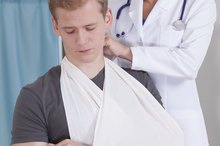Occupational Therapy Exercises for Lifting Arms
Lifting your arms can be very challenging after a prolonged period of illness or bed rest or an injury or stroke. However, your occupational therapist can help you improve your strength and range of motion using a variety of techniques, depending on your specific impairments. Understanding the purpose of your OT's interventions can guide you in completing your therapy and reaching your functional goals.
If you are experiencing serious medical symptoms, seek emergency treatment immediately.
Range of Motion
Range of motion often is very limited after a lengthy medical condition. Your therapist provides passive range of motion to your shoulders if you are completely unable to lift your arms to keep your arms from getting tight. Your OT may use a vibration massager over a weak muscle belly to help you recruit the muscle and initiate movement. As you progress, you begin active, assisted range of motion, with your therapist assisting you to complete arm lifts.
- Range of motion often is very limited after a lengthy medical condition.
- Your therapist provides passive range of motion to your shoulders if you are completely unable to lift your arms to keep your arms from getting tight.
Overhead Pulleys
Occupational Therapy Activity Ideas for CVA
Learn More
An overhead pulley may be useful to help improve your range of motion at your own pace, particularly if one arm is limited and the other is not, which often is seen with shoulder injuries or stroke. Place your more affected hand on the pulley handle first, then place your stronger hand on the other pulley. Moving your stronger hand downward lifts your weaker or tighter arm upward. Your therapist should encourage you to challenge yourself over time to complete the pulley exercise with straight elbows rather than bent elbows. The pulleys can be the least painful option for some patients, particularly if they prefer having control in your therapy.
- An overhead pulley may be useful to help improve your range of motion at your own pace, particularly if one arm is limited and the other is not, which often is seen with shoulder injuries or stroke.
Modalities
Modalities may be used by your OT to help you achieve greater range of motion and strength 1. Electrical stimulation can help control pain, increase muscle fiber strength and normalize nerve input. Ultrasound, infrared head or diathermy all can reduce pain and encourage tissue healing; they are usually imperceptible during the treatment. Trigger point release and massage are useful in normalizing muscle tone and reducing pain 1.
Therapeutic Activities
Military Press and Elbow Tendons
Learn More
Your OT may direct you to complete simple tasks to improve your overall range of motion. Using a "rainbow" device, or a pipe bent into a crescent shape with both ends facing downward, your OT may instruct you to move rings on the rainbow pipe from one side to the other to work your entire shoulder muscle girdle. Moving cones from one stack to another also can improve your arm-lifting capabilities. Functional tasks such as emptying the dishwasher and putting away dishes or folding laundry can further facilitate your recovery. Your therapist may have you perform any of these tasks with weighted cuffs on your wrists to add a strengthening component 1.
- Your OT may direct you to complete simple tasks to improve your overall range of motion.
- Your therapist may have you perform any of these tasks with weighted cuffs on your wrists to add a strengthening component 1.
Related Articles
References
Writer Bio
Melissa Sabo is an occupational therapist who started writing professional guidebooks for all Flagship Rehabilitation employees in 2009. Specializing in applied therapy and exercise for non-medical readers, she also coauthored a manual on wheelchair positioning. She graduated from the University of Pittsburgh with a Bachelor of Science in occupational therapy.









